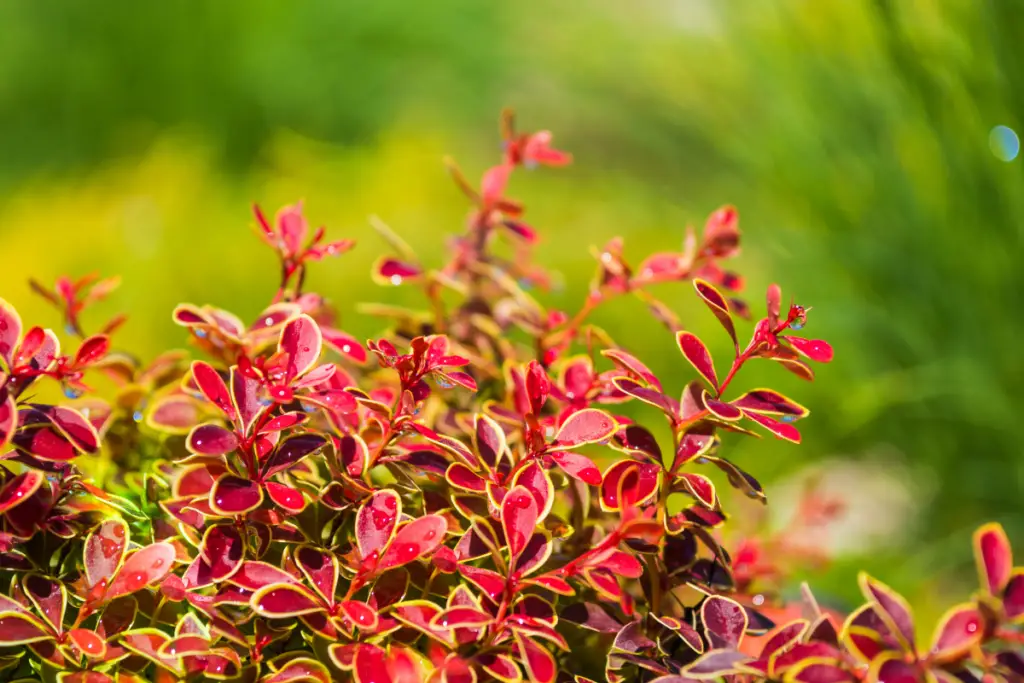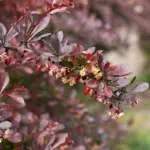Berberis thunbergii, also known as Japanese barberry, is a deciduous shrub that is native to Japan.
This plant is commonly used in landscaping due to its attractive foliage and bright red berries. However, Berberis thunbergii has become a major problem in many areas due to its invasive nature.
When Berberis thunbergii is introduced to new areas, it can quickly spread and outcompete native plants.
This can lead to a loss of biodiversity and negatively impact ecosystems. Berberis thunbergii is particularly invasive in areas with disturbed soils, such as along roadsides and in abandoned fields.

Table of Contents
Berberis Thunbergii Overview
Berberis thunbergii, also known as Japanese barberry, is a deciduous shrub that is native to Japan and eastern Asia.
It was first introduced to the United States in the late 1800s as an ornamental plant due to its attractive red berries and yellow flowers.
Native Range
Berberis thunbergii is native to Japan, China, and Korea. It grows in a variety of habitats, including forests, meadows, and along riverbanks.
In its native range, it is an important food source for wildlife and has been used for medicinal purposes for centuries.
Introduction to Invasiveness
While Berberis thunbergii was initially introduced to the United States as an ornamental plant, it has since become invasive in many areas.
It is able to thrive in a variety of habitats, including forests, fields, and along roadsides. The plant is highly adaptable and can grow in a range of soil types and light conditions.
One of the reasons Berberis thunbergii is so successful as an invasive species is its ability to produce large quantities of seeds.
The plant’s berries are attractive to birds, which eat the fruit and spread the seeds throughout the environment.
Once established, Berberis thunbergii can form dense thickets that crowd out native vegetation and alter the ecosystem.
In addition to its ability to outcompete native plants, Berberis thunbergii also has a negative impact on wildlife.
The plant’s thorns make it difficult for animals to navigate through the dense thickets, and the lack of understory vegetation makes it difficult for ground-dwelling animals to find shelter and food.
Invasive Range of Berberis Thunbergii
Berberis thunbergii, commonly known as Japanese barberry, is a deciduous shrub native to Japan. It is widely cultivated as an ornamental plant due to its attractive foliage and berries.
However, it has become invasive in many regions around the world, including North America, Europe, and other areas.
North America
In North America, Japanese barberry was first introduced in the late 1800s as an ornamental plant. It quickly spread and is now found in 31 states in the United States and several provinces in Canada.
It is most common in the eastern and midwestern regions of the United States, where it has invaded forests, fields, and other natural areas.
It is particularly problematic in areas with disturbed soils, such as roadsides and powerline rights-of-way.
Europe
Japanese barberry was introduced to Europe in the 19th century and is now widespread in many countries, including the United Kingdom, France, Germany, and Italy.
It is most commonly found in disturbed habitats such as roadsides, railway lines, and urban areas. In some areas, it has become a dominant species and is threatening native plant communities.
Other Regions
Japanese barberry has also become invasive in other regions around the world, including Australia and New Zealand.
In Australia, it is listed as a noxious weed in several states and is considered a threat to native vegetation. In New Zealand, it is classified as an environmental weed and is found in disturbed habitats such as roadsides and forest edges.
Overall, Japanese barberry is a highly invasive species that poses a significant threat to natural ecosystems.
Its ability to grow in a wide range of soil types and habitats, as well as its high seed production and bird-dispersed seeds, make it a difficult species to control.
Efforts to manage and control its spread are ongoing in many regions around the world.
Impacts of Berberis Thunbergii Invasiveness
Ecological Impacts
Berberis Thunbergii, also known as Japanese Barberry, is an invasive species that can have significant ecological impacts.
It can outcompete native vegetation, reducing biodiversity and altering the structure of ecosystems.
Berberis Thunbergii can also alter soil chemistry, making it more acidic and reducing nutrient availability for other plants.
This can further exacerbate the competitive advantage of Berberis Thunbergii and contribute to its dominance in invaded areas.
The dense growth of Berberis Thunbergii can also provide a habitat for small mammals, which can contribute to the spread of other invasive species.
In addition, the plant’s thorns can make it difficult for larger mammals to move through invaded areas, potentially altering wildlife behavior and distribution.
Economic Impacts
The invasiveness of Berberis Thunbergii can also have economic impacts. The plant can reduce the productivity of agricultural lands by outcompeting crops and reducing soil fertility.
It can also reduce property values by making areas less aesthetically pleasing and more difficult to access.
The control and removal of Berberis Thunbergii can also be costly, particularly in large-scale infestations.
Prevention and early detection efforts can help reduce these costs, but they require significant resources and coordination.
Social Impacts
The invasiveness of Berberis Thunbergii can also have social impacts. The plant can limit access to recreational areas, making them less enjoyable and potentially reducing tourism revenue.
It can also limit access to natural resources, such as forests and waterways, reducing the ability of local communities to use these resources for subsistence or economic purposes.
In addition, the presence of Berberis Thunbergii can contribute to the spread of tick-borne illnesses, as it provides a habitat for the ticks that carry these diseases.
This can have significant impacts on public health and increase healthcare costs.
Management and Control of Berberis Thunbergii
Prevention
Preventing the spread of Berberis thunbergii is the most effective way to control its invasive nature.
This can be achieved by avoiding planting it in gardens or landscapes and using alternative plants instead.
It is also important to avoid dumping yard waste or pruning debris in natural areas where the plant can take root and spread.
Early Detection and Rapid Response
Early detection and rapid response are crucial in controlling the spread of Berberis thunbergii.
Regular monitoring of natural areas and gardens can help detect the plant’s presence early on. If detected, immediate action should be taken to remove it from the area to prevent further spread.
Mechanical Control
Mechanical control involves physically removing the plant from the ground. This can be done by hand-pulling or digging out the root system.
It is important to remove the entire root system to prevent regrowth. Mechanical control can be effective for small infestations or in areas where chemical control is not feasible.
Chemical Control
Chemical control involves using herbicides to kill the plant. Glyphosate-based herbicides are effective in controlling Berberis thunbergii.
It is important to follow the manufacturer’s instructions when using herbicides and to apply them only to the target plant to avoid harming other plants or wildlife.
Integrated Pest Management
Integrated Pest Management (IPM) combines different control methods to effectively manage invasive species.
IPM for Berberis thunbergii may include a combination of prevention, early detection and rapid response, mechanical control, and chemical control.
It is important to use the most effective and environmentally friendly control methods available.
Conclusion
Overall, Berberis thunbergii is an invasive species that can be found in various regions of the world. It has been documented as invasive in North America, Europe, and Asia.
The plant is highly adaptable and can thrive in a variety of habitats, including forests, grasslands, and wetlands.
Invasive populations of Berberis thunbergii can have negative impacts on native plant and animal species. The plant can outcompete native species for resources and alter the structure and function of ecosystems.
Additionally, Berberis thunbergii can serve as a host for plant pathogens, which can further impact native species.
Efforts to control the spread of Berberis thunbergii include manual removal, herbicide application, and biological control methods.
However, prevention is often the most effective approach to managing invasive species.
This includes monitoring and early detection of new populations, as well as preventing the introduction of the plant to new areas.
- How to Build a Planter Box for Bamboo: A Step-by-Step Guide

- Can Robotic Lawnmowers Handle Steep Slopes?

- Do You Need a Specific Lawn for a Robotic Lawnmower? Expert Advice

- Are Robotic Lawnmowers Safe for Pets and Children? Safety Features of Robotic Lawnmowers

- Why Use Robotic Lawnmowers? Advantages of Using a Robotic Lawnmower

- Is the GARDENA SILENO City 300 Cordless or Corded? A Clear Answer














